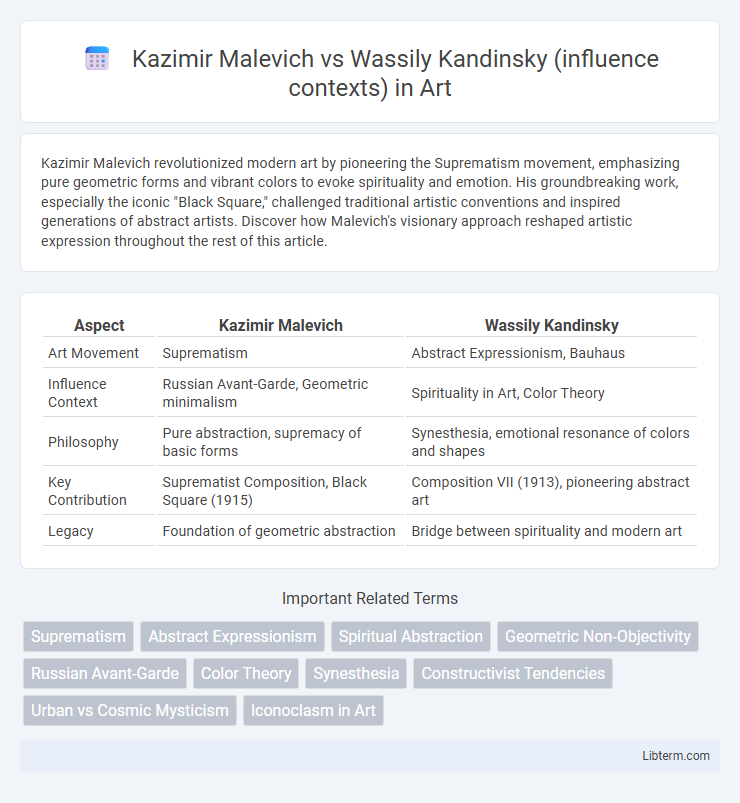Kazimir Malevich revolutionized modern art by pioneering the Suprematism movement, emphasizing pure geometric forms and vibrant colors to evoke spirituality and emotion. His groundbreaking work, especially the iconic "Black Square," challenged traditional artistic conventions and inspired generations of abstract artists. Discover how Malevich's visionary approach reshaped artistic expression throughout the rest of this article.
Table of Comparison
| Aspect | Kazimir Malevich | Wassily Kandinsky |
|---|---|---|
| Art Movement | Suprematism | Abstract Expressionism, Bauhaus |
| Influence Context | Russian Avant-Garde, Geometric minimalism | Spirituality in Art, Color Theory |
| Philosophy | Pure abstraction, supremacy of basic forms | Synesthesia, emotional resonance of colors and shapes |
| Key Contribution | Suprematist Composition, Black Square (1915) | Composition VII (1913), pioneering abstract art |
| Legacy | Foundation of geometric abstraction | Bridge between spirituality and modern art |
Introduction: Pioneers of Abstract Art
Kazimir Malevich revolutionized abstract art with his Suprematism, emphasizing pure geometric forms and the supremacy of color, which significantly influenced 20th-century modernism. Wassily Kandinsky pioneered abstraction through his exploration of spiritual and emotional expression in art, integrating music and color theory to shape the development of abstract expressionism. Their contrasting approaches forged foundational paradigms that continue to impact contemporary abstract art theory and practice.
Early Influences: Backgrounds and Artistic Milieus
Kazimir Malevich's early influences stem from Russian folk art, icon painting, and the avant-garde circles of Moscow that emphasized abstraction and Suprematism. Wassily Kandinsky drew inspiration from European Expressionism, theosophy, and his role in the Blaue Reiter group, blending spirituality with abstract forms. Both artists were shaped by the dynamic cultural and political upheavals of early 20th-century Russia and Europe, yet Malevich focused on geometric reduction while Kandinsky explored synesthetic color and musicality in art.
Philosophical Foundations: Theories Behind the Canvas
Kazimir Malevich's philosophical foundation centered on Suprematism, emphasizing pure geometric forms to convey spiritual purity and transcendence beyond material reality. Wassily Kandinsky, influenced by Theosophy and synesthesia, sought to evoke inner emotional and spiritual experiences through abstract shapes and vibrant colors, aiming to connect art with deeper metaphysical truths. Both artists profoundly transformed abstract art by integrating early 20th-century philosophical and spiritual theories into their innovative visual languages.
Suprematism vs. Abstraction: Defining Their Movements
Kazimir Malevich pioneered Suprematism, emphasizing basic geometric forms and pure artistic feeling detached from object representation, which contrasted with Wassily Kandinsky's abstraction rooted in spiritual expression and emotional resonance through color and form. Malevich's focus on flat, minimalist shapes in works like "Black Square" highlighted the supremacy of non-objective art, while Kandinsky's compositions, such as "Composition VII," explored dynamic abstraction to evoke psychological states. Their movements collectively shaped modern art by redefining abstraction--Malevich through reductive geometry and Kandinsky through expressive, symbolic abstraction.
Color and Form: Distinctive Visual Languages
Kazimir Malevich's Suprematism emphasizes pure geometric forms and limited color palettes to evoke spiritual and universal truths, prioritizing abstraction and flatness. Wassily Kandinsky's work uses vibrant colors and dynamic shapes to express inner emotions and musical harmony, integrating color theory with symbolic form. Their contrasting approaches highlight Malevich's focus on minimalism and metaphysical purity versus Kandinsky's rich psychological and synesthetic exploration of color and form.
Influence of Russian Avant-Garde Culture
Kazimir Malevich and Wassily Kandinsky significantly shaped the Russian Avant-Garde movement with their pioneering abstract art forms, emphasizing spiritual and philosophical dimensions. Malevich's Suprematism introduced geometric abstraction focusing on pure artistic feeling, while Kandinsky's expressionist works emphasized synesthetic experiences linking color and sound. Their contributions were rooted deeply in early 20th-century Russian cultural shifts, influencing global modern art through innovations in form and symbolism.
Spirituality in Art: Malevich and Kandinsky’s Perspectives
Kazimir Malevich and Wassily Kandinsky both explored spirituality in art through abstraction, yet Malevich focused on the suprematist principle of pure feeling via geometric forms, while Kandinsky emphasized the emotional resonance of color and music-like compositions. Malevich's Black Square symbolized a spiritual void representing transcendence beyond material reality, contrasting with Kandinsky's theosophical ideas linking art to a universal spiritual harmony. Their perspectives collectively shaped early 20th-century avant-garde movements by integrating spirituality as a core dimension of artistic expression.
Impact on Contemporaries and Successors
Kazimir Malevich's development of Suprematism profoundly influenced contemporaries by introducing radical abstraction focused on basic geometric forms, inspiring successors to explore pure visual language beyond representational art. Wassily Kandinsky's pioneering work in abstract art, emphasizing spirituality and emotional expression through color and form, shaped a generation of artists who prioritized inner experience and synesthetic effects in their work. Both artists significantly impacted modern art movements, with Malevich's geometric abstraction informing Minimalism and Constructivism, while Kandinsky's theories contributed to Expressionism and Abstract Expressionism.
Critical Reception: Then and Now
Kazimir Malevich's radical Suprematism initially faced skepticism for its abstract minimalism, contrasting with Wassily Kandinsky's recognition as a pioneer of expressionist abstraction, which was more readily accepted by early 20th-century critics. Contemporary scholarship reevaluates Malevich's influence as foundational to abstract art, highlighting his philosophical depth and impact on minimalism, while Kandinsky's emphasis on spiritual and emotional expression continues to be celebrated in the context of modernist art movements. Both artists are now viewed as essential figures in the evolution of abstract art, with ongoing critical discourse emphasizing their differing approaches to form, color, and conceptual intent.
Legacy: Lasting Influence on Modern Art
Kazimir Malevich pioneered Suprematism, emphasizing pure geometric abstraction that profoundly influenced the development of minimalism and abstract expressionism in modern art. Wassily Kandinsky's exploration of color theory and spiritual abstraction laid the groundwork for abstract art by connecting visual form with emotional and symbolic meanings, inspiring generations of artists and movements such as Expressionism. Both artists' legacies continue to shape contemporary art discourse through their innovative approaches to abstraction and the articulation of non-objective art principles.
Kazimir Malevich Infographic

 libterm.com
libterm.com